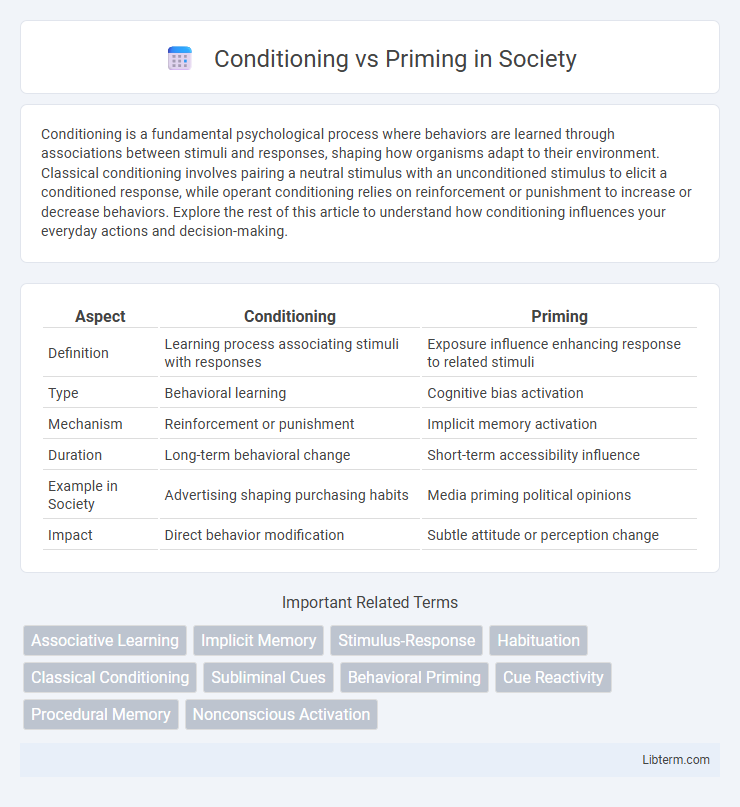Conditioning is a fundamental psychological process where behaviors are learned through associations between stimuli and responses, shaping how organisms adapt to their environment. Classical conditioning involves pairing a neutral stimulus with an unconditioned stimulus to elicit a conditioned response, while operant conditioning relies on reinforcement or punishment to increase or decrease behaviors. Explore the rest of this article to understand how conditioning influences your everyday actions and decision-making.
Table of Comparison
| Aspect | Conditioning | Priming |
|---|---|---|
| Definition | Learning process associating stimuli with responses | Exposure influence enhancing response to related stimuli |
| Type | Behavioral learning | Cognitive bias activation |
| Mechanism | Reinforcement or punishment | Implicit memory activation |
| Duration | Long-term behavioral change | Short-term accessibility influence |
| Example in Society | Advertising shaping purchasing habits | Media priming political opinions |
| Impact | Direct behavior modification | Subtle attitude or perception change |
Understanding Conditioning and Priming
Conditioning involves forming associations between stimuli and responses, typically through repeated exposure or reinforcement, as seen in classical and operant conditioning models. Priming activates related mental pathways by presenting specific stimuli, which influences subsequent perception, memory, or behavior without conscious awareness. Understanding conditioning and priming is crucial for recognizing how automatic responses and implicit memory shape human behavior and decision-making processes.
Key Differences Between Conditioning and Priming
Conditioning involves the learned association between stimuli and responses, typically demonstrated through classical or operant conditioning frameworks, where behavior is shaped by reinforcement or punishment. Priming refers to the subconscious influence of a prior stimulus on the response to a subsequent stimulus, enhancing cognitive processing speed or accuracy without direct behavioral training. Key differences include conditioning's overt behavioral changes driven by consequence-based learning, whereas priming operates through implicit memory activation without conscious awareness or explicit training.
Types of Conditioning Explained
Classical conditioning involves learning through association, where a neutral stimulus becomes linked to an unconditioned stimulus, eliciting a conditioned response. Operant conditioning focuses on behavior modification through reinforcement or punishment to increase or decrease desired actions. Observational conditioning occurs by imitating others' behaviors, highlighting the role of social learning in shaping responses.
Types of Priming in Psychology
Priming in psychology involves exposure to a stimulus influencing a response to a subsequent stimulus, with types including semantic priming, where related words trigger faster recognition; perceptual priming, based on the form or structure of a stimulus; and conceptual priming, involving the activation of related concepts or ideas. Conditioning contrasts priming by associating stimuli with responses through reinforcement, whereas priming operates through implicit memory activation without conscious awareness. Understanding semantic, perceptual, and conceptual priming clarifies mechanisms underlying automatic processing and cognitive facilitation in learning and memory tasks.
Mechanisms Behind Conditioning
Conditioning relies on associative learning where a neutral stimulus becomes linked to an unconditioned stimulus, eliciting a conditioned response through repeated pairings. This process primarily engages neural pathways involving the amygdala and cerebellum, facilitating memory formation and behavioral adaptation. In contrast to priming, which activates existing neural associations, conditioning creates new connections that modify future responses.
How Priming Influences Perception
Priming influences perception by activating specific associations in memory, which shapes how individuals interpret sensory information and events. Exposure to certain stimuli, such as words or images, can unconsciously bias attention and decision-making, leading to altered responses based on the primed concepts. This cognitive process impacts behaviors and judgments by increasing the accessibility of related thoughts and feelings in the brain.
Real-World Applications of Conditioning
Conditioning plays a crucial role in real-world applications such as behavioral therapy, education, and marketing by establishing associations between stimuli and responses to modify behavior. Classical conditioning is widely used in treating phobias through systematic desensitization, while operant conditioning shapes behavior in classroom management and animal training using reinforcement and punishment. Marketing strategies leverage conditioning by pairing brands with positive stimuli to increase consumer preference and loyalty.
Everyday Examples of Priming
Priming influences behavior by exposing individuals to specific stimuli that activate related mental associations, such as seeing the word "yellow" leading to faster recognition of "banana." In everyday life, background music that evokes calmness can prime people to make more patient decisions, while exposure to words related to cleanliness increases the likelihood of socially desirable behavior. These subtle cues shape implicit responses without conscious awareness, distinguishing priming from conditioning, which relies on learned associations through reinforcement.
Conditioning vs. Priming: Which Is More Effective?
Conditioning and priming both influence behavior but differ in mechanism and effectiveness depending on the context. Conditioning, such as classical or operant conditioning, creates strong, lasting behavioral changes through repeated associations or reinforcement, making it highly effective for habit formation and learning new skills. Priming, by subtly activating related memories or responses without conscious awareness, is quicker but usually less durable, proving most effective in scenarios requiring immediate but temporary behavior shifts.
Future Implications in Behavioral Science
Conditioning involves learning through association, significantly influencing future behavior by establishing automatic responses, whereas priming activates specific schemas or concepts that subtly shape perception and decision-making. Future implications in behavioral science highlight enhanced applications in personalized interventions, such as adaptive therapy models and AI-driven behavior modification, improving efficacy in mental health and habit formation. Advanced neuroimaging and machine learning integration promise deeper insights into the dynamic interplay between conditioning and priming, enabling precise behavioral predictions and tailored behavioral change strategies.
Conditioning Infographic

 libterm.com
libterm.com